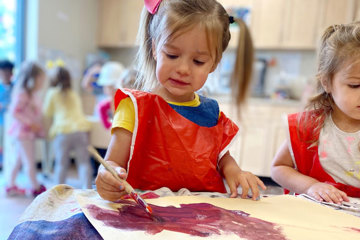8 Practical Ways to Encourage Your Child Through the Stages of Early Writing

Many children can write their names at five-years-old. While some will write sooner and others later, most children at this age can create a string of letter-like symbols they identify as their names. This may feel like the beginning of your child being a writer! But it’s actually the culmination of many years of practice and fine muscle development.
There are generally eight stages of early writing. Each is important and most children will pass through all of them before using letters to represent their ideas. Here are some practical tips to encourage your child on their early literary path.
1. Drawing
Your child will make marks on paper to explore how the tool works. She is more interested in the fact she’s making marks than in creating something in pictures or words.
How to encourage:
- Provide surfaces (paper, easel, chalk boards) and tools (crayons, markers, chalk, etc.) to make marks.
- Create spaces where your child can move his arms and hands in big motions to make marks.
- Talk with your child about the marks they’re making and help them connect their movements with the resulting marks.
- When reading with your child, run your fingers along the words to help her connect written and oral language.
2. Random scribbling
Your child will begin to give meaning to their marks. They can tell you what they’ve created or will set out to draw something in particular.
How to encourage:
- You can say, “Tell me about your picture” to continue to build the understanding that the marks on the paper have meaning.
- Write what your child says about their work under the picture.
- Point out and read words to help your child notice that words are different from pictures (even though both represent ideas).
- Model how writing is useful in real life. This may include making lists, following recipes, reading instructions, sending messages, etc.
3. Controlled scribbling
Your child will begin to scribble in rows or circular motions; primarily from left to right and from the top of the page to the bottom. They often begin to talk about what they “write” as opposed to what they “draw.” They will interpret their marks when asked.
How to encourage:
- Ask your child to read you their stories.
- Continue to model conventional writing. As you write, show your child the marks you make and talk about the letters you use to form the words.
4. Letter-like forms
Your child will begin to form distinct symbols that look like letters. These may look like triangles, circles, lines, squiggles, etc.
How to encourage:
- Invite your child to read their words to you.
- Write their words as they tell you their stories. Say the letter names as you write them.
- Encourage your child to sign their name, and write in natural ways (signing cards, labeling their art and written work, etc.).
5. Random letters
Your child will write recognizable letters. However, the letters may be scattered throughout the page and there won’t be a connection between the words they read back and the letters they wrote. This shows that your child understands the idea that letters convey meaning, but they don’t yet connect specific letter shapes with the sounds they represent.
How to encourage:
- Spell out words as you write them. Talk about the sounds that each letter makes as you write it.
- When reading with your child, pause at times and move your finger along a word (to show how it moves from left to right), say the letters and sound out the word (to show how the letters represent sounds).
6. Patterned letters
Your child will begin to write strings of letters that look like words and sentences, but there still won’t be a connection between the letters and what they mean.
How to encourage:
- Ask your child to read their work to you and point out and name the letters you see and talk about the sounds the letters represent.
- Provide your child with opportunities to write and help them spell out words. For example, they can help you add items to a grocery list or make a note to remind the family of something.
7. Inventive/phonetic spelling
Your child is now connecting letters with the sounds they represent. At this stage, a word might be represented by one letter, a couple letters, or a very phonetic representation of a word.
How to encourage:
- Help your child sound out and study words. Point out when you see a word with unconventional spelling.
8. Conventional spelling
Your child will use conventional spelling rules and writing to convey messages. While there may still be some misspellings, grammar mistakes, or letters written backwards, they understand and employ the forms and uses of writing.
How to encourage:
- Continue to encourage your child’s writing and enthusiastically read what they create.
While there are steps you can take to support your child in each stage, there is no value in trying to rush into the next stage. Writing, like so many other behaviors, is a complex coming together of experience and muscle and cognitive development.
Rushing children through the stages can actually slow down the process. Frustration and feelings of failure can result when children are pushed into behaviors they just aren’t developmentally ready for. These feelings can make children hate writing and reluctant to continue.
To create a strong writer, provide your child with support, tools, writing models, and instill a love of the written word. And, before you know it, those scribbles will transform into brilliant stories of flight and fancy.
For more information:
- https://i.pinimg.com/originals/3f/d6/1f/3fd61f5ca37ece92debdeae168eae2a9.jpg
- https://www.zerotothree.org/resources/305-learning-to-write-and-draw


